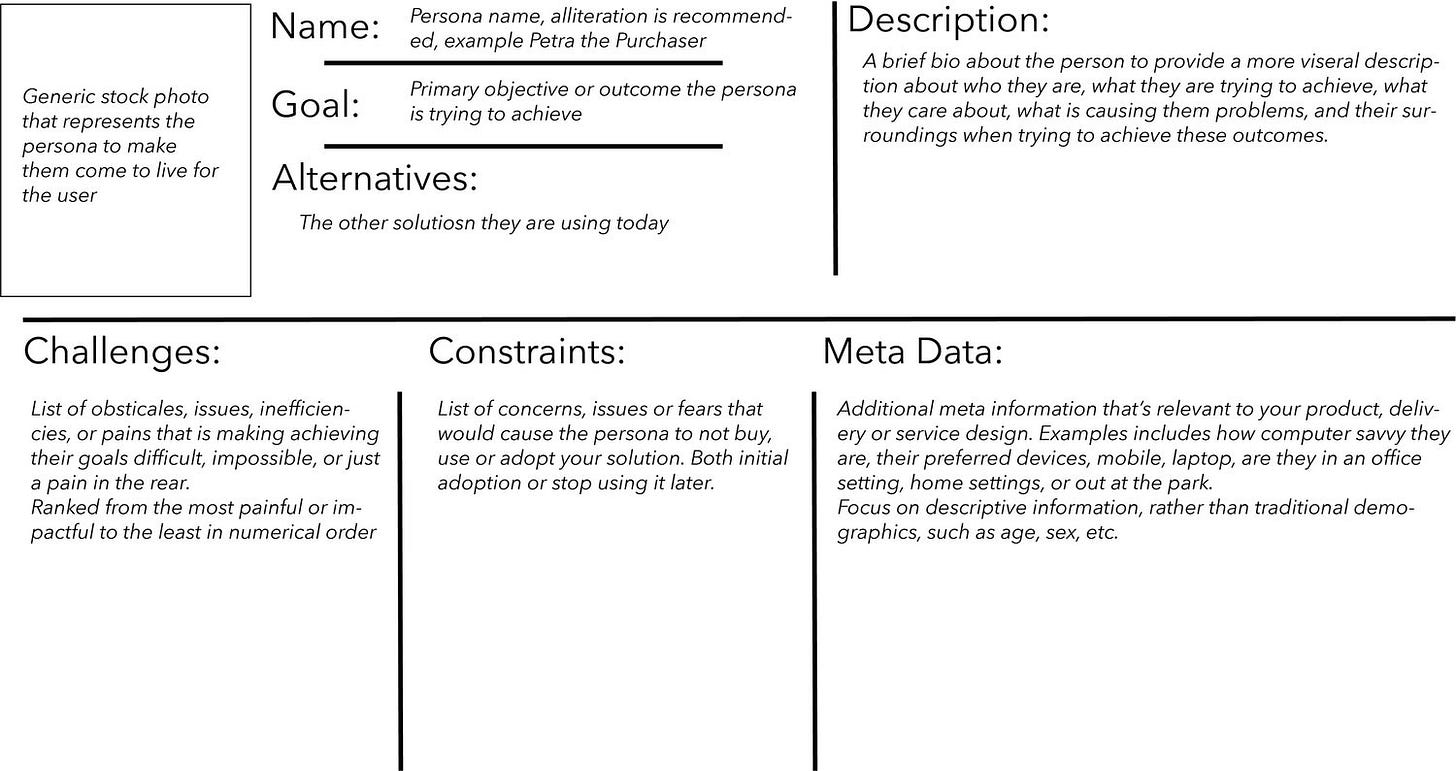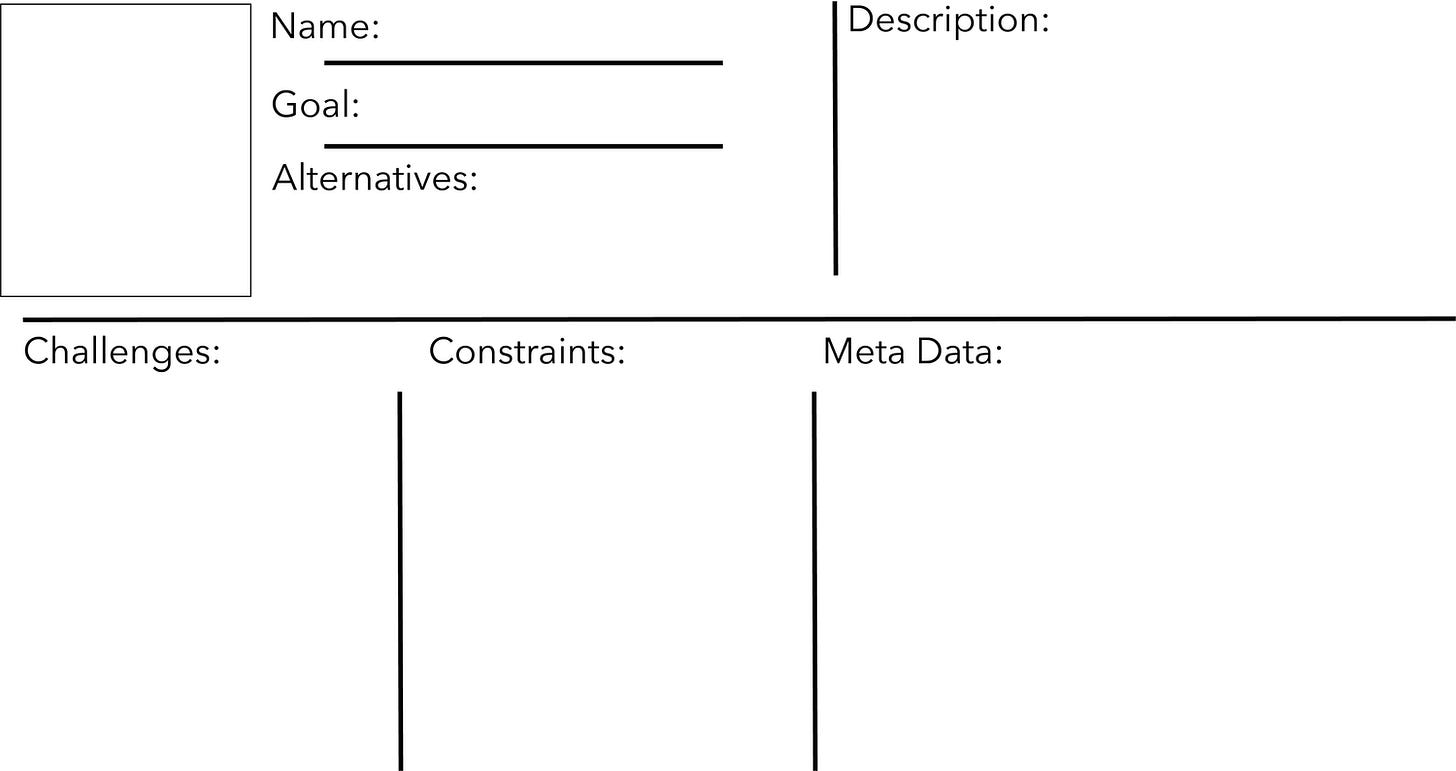Persona - Basic
Basics on building buyers and user persona to help you make better product decisions

There are a lot of persona templates out there, and they all have their strength and weakness. This template is prioritized to help product managers and teams to ideate the right solutions; prioritize specific features or requirements to maximize solutions; clearly advocate for the customers’ and users’ needs; sales and marketing messaging.
You may see fields you’re already familiar with from other persona templates and some new fields or new ways to use fields you’re already familiar with. Also, this template is designed to be a universal template, so you can use it for Buyers, Users, or those who may influence or impact the buying decision.
Template Overview
Name:
The name provides a quick reference to the persona and can be a quick shorthand for the needs, challenges, and information about the persona. Ideally, it should include a proper name with the role or label that describes the persona’s most salient characteristic. This could be their job, their title, or their relationship with your product and others. I highly recommend using alliteration when you create the name; it’ll help you when you’re trying to use the persona to keep the teams aligned and focused.
Here are some examples:
By their job: Robin the Repair person, Gabe the Gardener, Nigel the Night Watchman
By job title: Ellen the Executive, Cheryl the CEO, Sal the Sales Rep
By relationship to your product: Debra the Donor, Betty the Big Spender, Larry the Loyalist
By their relationship with others: Stan the Student, Dave the Stay-at-home Dad, Allison the Alumni
Goal:
Goal is to describe the outcome the persona wants or the persona’s core need. Limit to one goal, or couple the primary goal with one or two linked secondary goals if needed. For example, a diner at a fine dining restaurant could be looking to impress their friends or dates, create fond memories with friends and family, or enjoy the total dining experience, both tasty food and a great atmosphere. Though a person may have all three goals depending on the day, separating each goal into their own persona is best to make analysis easier later.
Alternatives:
Alternatives are any other products or ways they use to achieve their goals. These could be products you’re actively competing against, like Coke vs. Pepsi, or things that aren’t even designed to compete with you, like people using Microsoft Excel for project planning. This is why setting the goal first is critical. If you understand the real underlying need, you will find alternatives you did not expect and new market segments for your products.
Challenges:
Challenges are all the things that make reaching the goal or fulfilling those needs difficult, even impossible. They could include anything that makes achieving the goal impossible, inconvenient, time-consuming, difficult, or just plain annoying. If you look at the world before Social Media, sharing your life with your friends, family, and the world is difficult and time-consuming, and when it comes to reaching the world, it is completely impossible. You then rank them from the most painful and impactful to the least. For example, if it makes reaching their goal impossible is number one, slight annoyance would be placed last.
Ranking them based on their impacts will help you to determine what will provide the greatest impact, i.e., the highest value, to your buyers or users, enabling you to prioritize your roadmap to achieve the highest ROI possible.
Constraints:
Constraints are things that might cause them to abandon your product. For example, it could be a buyer who might not buy or renew your product or a user who might decide not to use it or cause them not to want to return. This could be the cost, the difficulty of use, poor customer service, or unstable connection. The information helps you with emotive design, and depending on which personas you’re targeting, it’ll help you know where you could stop with your MVP. Because if you don’t address these constraints, the product will not be viable with your target personas, regardless if they are the buyer, the user, or a decision influencer.
Meta Data:
Here are all the additional pieces of information to better understand the persona in the context of your product. For example, if you’re building a new IoT-enabled fridge, knowing how tech-savvy your users are will be important when designing your product, or if you’re building an age-related cognitive improvement mobile app, you may want to add their age or cognitive level in addition to how technology or mobile app savvy they are.
Description:
This is where your persona really comes to life! Putting their goal, challenges, alternatives, constraints, and relevant meta-information together into a story will make it easier to help you align the rest of the organization. People love a good story, and a good story about the persona will make the persona feel real to your teams and give them extra motivation and creativity when building the product. It will also help to put your strategy into context for the executives, making upward alignment easier.
Photo:
Ideally, you want to include a stock photo appropriate for your persona. In conjunction with the description, this will make using persona as a communication tool easier.
Key Pitfall:
An often repeated comment attributed to Henry Ford, “If I asked my customers what they wanted, I’d have built a faster horse.” exposes the issue many product teams run into, separating what customers say they want from what the customer actually needs. If you get this wrong, you’ll end up building a faster horse, which is not scalable or help you to achieve long-term product success in today’s shifting market.
This holds true for all aspects of the Persona. Getting to the real underlying and often unspoken needs, challenges, or constraints is important. The better you’re at this, the more likely you’ll build exactly what will delight your customers, thus winning in the market against all other alternatives.
To find the underlying need or goal, it is important to ask additional follow-up questions to ensure you understand the motivation behind a buyer, user, or decision influencer’s initial response when you ask them, “what do you need or want?”.
If you need help to better model your buyers and users, reach out.






